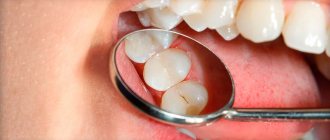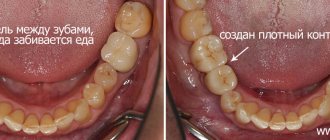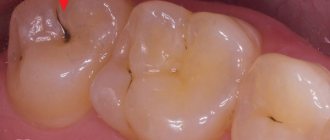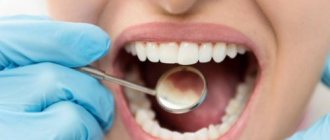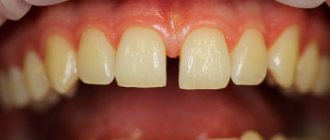In this article
- Who is susceptible to developing interdental caries?
- How to detect caries in interdental spaces?
- Features of the treatment of interdental caries
- Interdental caries of the anterior teeth: what should be done?
- Specifics of treatment of interdental caries of chewing teeth
- How is caries between teeth treated when molars and premolars are affected?
- Prevention of interdental caries
Interdental caries is one of the most “inconvenient” and difficult to treat. In this article we will tell you why it appears, how caries between two teeth is treated, and whether its occurrence can be prevented using preventive measures.
What is interdental caries called and why does it occur? Caries between the lower or upper teeth located next to each other, joint to joint, is called interdental. The denser the arrangement of adjacent teeth in relation to each other, the greater the likelihood of developing carious lesions of the tooth enamel in the area of the joints. When the teeth are tightly packed together, food particles become stuck in the spaces between the teeth, which are difficult to remove with a brush, even if a person regularly brushes their teeth twice a day. To clean the interdental spaces, you need to constantly use dental floss, floss or a special device - an irrigator.
Unfortunately, most people limit themselves to using a toothbrush and toothpaste, as a result of which high-quality cleansing of the interdental spaces does not occur. Accumulated food debris is a favorable environment for the development of microbes and the formation of plaque, which leads to the development of caries between teeth. Due to the location and anatomical features, interdental caries of the anterior teeth most often occurs. Its early detection and timely treatment play an important role from the point of view of not only health, but also aesthetics, because caries between the front teeth, which is located in the most visible place, spoils a person’s smile and appearance. Its specificity is also that the enamel of the front incisors is thinner than the enamel of other teeth, so carious lesions spread deeper and deeper, and treatment presents certain difficulties.
Who is susceptible to developing interdental caries?
Carious lesions on the lateral surfaces of adjacent teeth can occur in anyone, including children. But the following categories of people are especially susceptible to the formation of interdental caries:
- those who eat poorly: consume a lot of sweet foods and drinks, few solid vegetables, fruits and foods rich in fluoride, calcium, phosphorus;
- those who have problems with oral hygiene (do not brush or brush their teeth poorly, do not use dental floss or irrigator to clean the interdental spaces);
- those whose normal salivation process is disrupted;
- when there is a gap between the teeth that is too narrow or closed at the bottom and widened at the top, into which food easily gets clogged.
How to detect caries in interdental spaces?
One of the specific features of interdental caries is that it is difficult to diagnose. Since enamel damage is located at the junctions of teeth, it can be quite difficult to detect it yourself. Therefore, caries between teeth is rarely diagnosed at an early stage, when it is possible to manage with conservative methods and not prepare the tooth. Much more often it is detected already in the presence of symptoms in the form of pain or a reaction to cold/hot.
The dentist diagnoses interdental caries using several basic methods:
- External visual inspection using a mirror and probe. Only an experienced dentist can detect areas affected by caries and dark spots on the enamel in hard-to-reach areas.
- If the teeth are very closely spaced, a diagnostic examination may be difficult, and then the dentist will order an x-ray, which will show the presence of a carious cavity in the tooth.
- Sometimes, as an alternative to x-rays, a modern sound diagnostic method is used.
After making a diagnosis, the question arises of how caries between teeth is treated.
Diagnostics
- visual examination of the oral cavity
. It is performed using special instruments to assess the condition of the oral cavity. A dental mirror allows the specialist to carefully examine the distal surfaces: to detect the localization of spots, stripes/dots of black, brown color, and a carious lesion in the gap. The probe helps differentiate the depth of the cavity; - percussion method
. Intended for diagnosis and identification of pathological segments by tapping. The diseased unit reacts with a muffled sound, the patient experiences pain and severe discomfort; - radiography
. The x-ray image shows the distance of the lesion from the pulp, the level of prevalence of the process; - transluminescence
. Luminescence (transmission through a filter with an ultraviolet beam) and fiber optic exposure (transmission with a light beam) are practiced. Damaged areas appear darker than healthy areas; - coloring
. Application of staining markers (potassium iodide/methylene blue solution). The technique allows you to diagnose pathology and distinguish it from fluorosis/hypoplasia.
In difficult cases, fissurotomy (opening the grooves on the surface of the molars) and electroodontometry are used to determine the degree of pulp damage.
Features of the treatment of interdental caries
Treatment tactics depend on several factors:
- stages of the carious process;
- localization of caries.
In terms of the depth of damage, interdental caries can vary from the spot stage, when there is no carious cavity yet, but only a section of demineralized enamel is found, to medium and deep caries, when a large carious cavity forms in the dentin and there may be a risk of pulpitis and other complications.
At the stain stage, it is possible to treat teeth using conservative methods, without preparation. As a rule, this is remineralization by simple or deep fluoridation, infiltration method or ozone therapy. These methods strengthen tooth enamel, increase its protective functions and resistance to external influences.
At the stages of superficial, medium and deep caries, the disease will have to be treated surgically - through tooth preparation, removal of affected tissue and further filling of the affected areas.
At the same time, the main difference between interdental caries and other types is that it is necessary to treat not one, but two teeth at once in the area of contact surfaces.
Interdental caries of the anterior teeth: what should be done?
The most unpleasant and “ugly” caries occurs between the front teeth. If the disease is not detected at the spot stage, then treatment will be carried out approximately according to the following scheme:
- a drug with an anesthetic effect is applied to the affected area;
- clean areas affected by caries from dental plaque and other deposits to prevent the spread of pathology to neighboring areas;
- isolate the affected teeth using a latex napkin (rubber dam) to prevent saliva from getting into them or being injured during dental treatment;
- carious cavities are prepared, the affected tissue is removed on the contact surfaces between the two front teeth using a drill;
- treat the interdental areas with antiseptic solutions (for example, chlorhexidine), and then with adhesive compounds, which improves the fixation of the filling to the tooth walls;
- teeth are filled, and then polished and ground in such a way as to restore their natural anatomical shape and the contours of the interdental spaces as much as possible;
- in case of severe damage, when it is not possible to restore the aesthetics of the front teeth with a filling, they are restored using crowns or veneers.
Both upper and lower teeth are treated in this way.
We recommend that you read
Dental treatment during pregnancy
Treatment of anterior teeth
Dental filling
Canal filling
How is caries between teeth treated when molars and premolars are affected?
The algorithm is like this:
- First, anesthesia is performed. If the lesion is shallow, sometimes topical anesthesia is sufficient; for deeper stages, an anesthetic injection is given with a drug to which the patient is not allergic.
- The affected areas are cleaned of plaque and tartar, and a rubber dam is applied.
- Carious cavities are prepared; in most cases, not only the affected tissue is removed from the chewing teeth, but also some of the healthy tissue to provide the necessary access;
- The cavities are treated with disinfectants and treated with adhesives.
- The tooth is filled with modern photocomposite materials, which are illuminated with special lamps. To restore the side walls of the chewing teeth and ensure tight contact between them, the dentist uses special wedges and matrices.
- At the final stage, the restored surfaces are polished.
Prevention of interdental caries
Interdental caries is difficult to diagnose and treat; it affects the contact surfaces of several teeth at once. Therefore, it is much easier to prevent its occurrence than to treat it.
The following preventive measures will help reduce the risk of developing caries between teeth:
- brushing your teeth twice a day with fluoride toothpastes (unless your dentist recommends a different toothpaste);
- After each brushing of your teeth, clean the interdental spaces with a special floss;
- use an irrigator: with a powerful stream of water it cleans not only the interdental spaces, but also gum pockets, areas under crowns and braces and other hard-to-reach areas where food debris can accumulate;
- It is recommended to reduce the consumption of foods rich in simple carbohydrates and sugars, because this is what promotes the growth of bacteria in the oral cavity;
- do not snack between meals, especially sweet and sticky foods;
- visit the dentist once every six months for a preventive examination and for professional teeth cleaning using special equipment;
- on the recommendation of a doctor, promptly remineralize the enamel with fluoride and calcium preparations in order to stop the process of carious lesions at an early stage.
Following these simple rules will help reduce the risk of developing caries between teeth several times and maintain a healthy and beautiful smile for a long time.
Why do stains appear on teeth: the main reasons
The initial form of caries can be provoked by various factors, but most often this happens due to the formation of an acid-base imbalance in the oral cavity. A large number of harmful microorganisms constantly live in the mouth, which actively participate in the process of food decomposition. Food particles tend to remain between the teeth and on their surface, which leads to the destruction of tooth enamel.
Other reasons leading to the destruction of the structure of the enamel layer on the teeth include:
- incomplete or poor oral hygiene. After some time, failure to comply with hygiene rules leads to the appearance of white plaque on the teeth, which acts as an excellent environment for the accumulation of pathogenic bacteria. As a result, microorganisms produce harmful acids, which negatively affects the condition of tooth enamel. This process can be prevented by regular oral hygiene procedures. If, nevertheless, destruction of the enamel is observed, then treatment of caries at the spot stage will help prevent complications;
- hereditary predisposition. Even at the moment of conception and during intrauterine development, the structure and strength of tooth enamel is laid in the baby. When the mother’s body during this period lacks fluoride, calcium, vital vitamins and minerals, the risks that the child’s teeth will be excessively fragile and prone to the formation of carious processes are maximum;
- poor nutrition. Tooth enamel will be hard and durable if the daily diet contains foods high in calcium, fluorine and phosphorus (fish, cheese, cottage cheese, nuts, milk). But foods containing a large amount of carbohydrates (sweets, baked goods) must be kept to a minimum. This will protect the enamel from premature destruction;
- changes in the composition of saliva and its increased viscosity. Along with the fact that saliva is involved in the process of softening the food consumed, it also cleanses the surface of the teeth from food debris. When, due to changes in the structure of saliva, its acidity increases, a constant destructive effect on the teeth is formed. This process leads to the development of carious pathologies.
Often the initial form of caries appears in the area of the neck of the tooth, which is difficult to clean with a toothbrush. Regular examination of the condition of the teeth by a dentist and, if necessary, professional cleaning will help prevent the development of carious processes.


